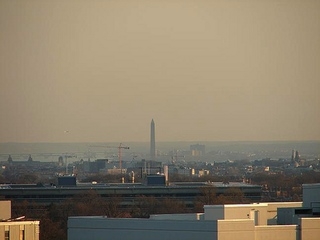
Today the Washington metro area lands on a top five US cities list for something less than glamorous: smogginess.
According to a report released today by Environment America, DC has had about three times as many smog days as traditionally industrial cities like Pittsburgh, Cleveland, and Detroit since the beginning of 2010.
A smog day is counted as a day in which air quality surpasses the national ozone standards—standards that are laxer under President Barack Obama than they were set to be under a proposal set forth by President George W. Bush. The standards have hovered at 84 parts per billion (ppb) since 1997. That’s where they’ll stay, since Obama took back his pledge to improve on Bush’s proposed (but never enacted) 75 ppb several weeks ago.
Both of those levels are far higher than the 60 to 70 ppb considered safe by an independent, congressionally-established committee of scientists. According to Environmental Protection Agency Administrator Lisa Jackson, they also both happen to be “legally indefensible.”
According to Lauren Randall, who worked on Environment America’s new report, pollution from other states may be to blame for Washington’s poor air quality. “We are downwind from states like Ohio and Pennsylvania that have large amounts of power plants that spew out this smog-forming pollution,” she says, specifying coal emissions as especially bad for air quality. These pollutants compound in sunlight, which Washington gets plenty of, creating the perfect recipe for smog.
Studies show that on high-smog days people have increased respiratory difficulty and are more likely to die prematurely. The economic impacts of smog standards may be debatable, but the health impacts are considerably less so.












